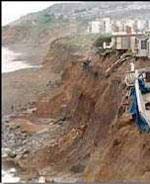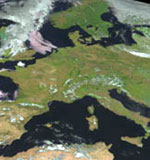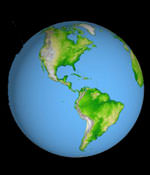
Image credit: NASA
The spectre of global warming and rising ocean levels have been a concern for many years, but NASA has some real numbers to help measure the situation. According to the Topex/Poseidon and Jason satellites, sea levels have been rising an average of 2.8 millimetres a year since observations began in 1992. Whether rising sea levels are caused by human impact or a natural cycle still isn’t clear, but the impact is already being felt in coastal communities around the world with water inundating low-level areas and an increased rate of beach erosion.
Stack two dimes on top of each other. Their height is a tiny fraction less than global sea level is rising each year. The increase looks small, but the consequences are potentially huge. Rising sea level threatens to inundate low-lying regions, such as the Chesapeake, and dramatically increase coastal and beach erosion around the world.
While tide gauges have been used to determine sea level for hundreds of years, the most complete global measurements now come from space. “Tide gauges can’t detect an increase in the rate of sea level rise soon enough to be useful for detecting climate change,” says Bruce Douglas, a senior researcher at Florida International University, Miami, Fla. “Tide gauges can’t measure everywhere. They’re on practically every rock in the ocean, the problem is there just aren’t enough rocks.”
In contrast, the Topex/Poseidon satellite observes the entire ocean and has been making precise measurements of global sea level since it was launched in 1992. Its successor, Jason, is now continuing the same ocean observations.
“Right now Topex/Poseidon has been seeing an average yearly increase of 2.8 millimeters (0.11 inches) in global sea level,” says University of Colorado engineering professor Dr. Steve Nerem, a member of the Topex/Poseidon and Jason 1 science team.
Global sea level is the average of all local rates. If global sea level is rising by 2.8 millimeters a year, the local rate in some areas is much higher, as much as 5 millimeters (0.2 inches) or more over long periods. In some areas it is less.
One of the big questions facing scientists and the public, especially the more than two billion of us who live within 100 kilometers (62 miles) of a coast, about the rise in sea level is “why?”
“We don’t know yet exactly what is causing it,” says Nerem. “The jury is still out.” The current rise in global sea level could be part of some natural, yet unidentified, decades-long climate pattern, Nerem says. “During 1997-1998 El Ni?o, the global average went up 15 millimeters (0.6 inches) as a result of increased ocean temperatures and then went down again.”
However, sea level is a barometer of climate change, and the rise could be a result of a warming Earth. “While the rate of increase we see is consistent with climate change models, we can’t say for sure if that is the cause,” Nerem says. “We’re just starting to ask those questions.”
“It looks like sea level rise as we now observe it began in the middle of the 19th century,” says Douglas, an expert on the history of sea level rise and its consequences. “We have a preponderance of evidence that the current rate is considerably faster than for the previous several thousand years, although there is still some disagreement among scientists about this.”
The two major factors that determine sea level are temperature and ocean mass. Warm water expands and raises sea level. Water added to the ocean from melting glaciers or ice sheets also causes sea level to go up. Figuring out just how much of the current sea level rise is due to each of these factors is difficult.
“Our best guess is that thermal expansion accounts for about 0.5 millimeters (.02 inches) per year rise in sea level or five centimeters (2 inches) per 100 years,” says Douglas. “If global sea level is rising at more than 20 centimeters (8 inches) per hundred years, then where is the water coming from? Mountain glaciers could account for three or four centimeters (1.2 to 1.6 inches), so that leaves Earth’s great ice sheets in Greenland and Antarctica. Are they losing or gaining? That’s a controversial question.”
Scientists expect to have some answers soon. NASA’s new Grace mission will be able to calculate the ocean’s mass, helping pinpoint whether rising sea level is a result of more water in the ocean or expansion due to warming waters. A new generation of tide gauges and monitoring devices provide details on sea level changes in specific locations.
Meanwhile, Jason continues the global sea level measurements begun by Topex/Poseidon more than 11 years ago, building up a record of sea level change that may help explain the past and predict the future. Ironically, Topex/Poseidon was never expected to be able to make precise enough measurements to monitor something as small as millimeter changes in global sea level. “It’s a 100 times more accurate than we expected it to be before launch,” says Douglas. Jason 1 may improve on these measurements even more.
Original Source: NASA/JPL News Release






